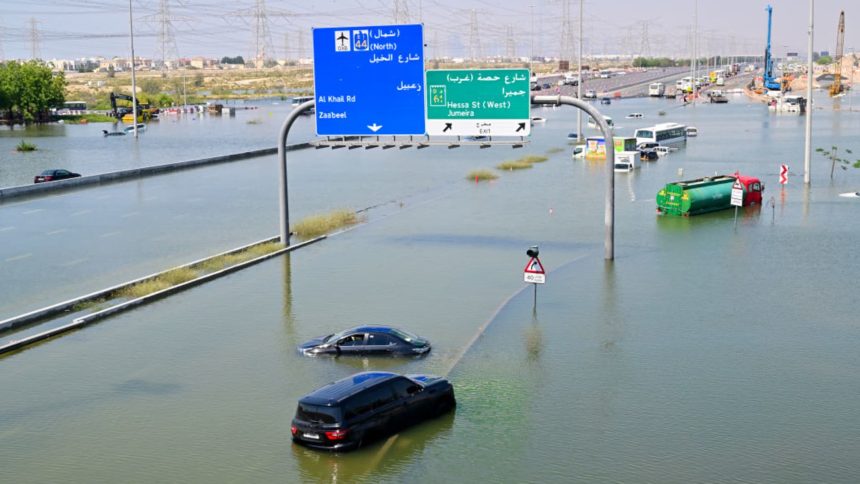The United Arab Emirates continues to reel from floods caused by the heaviest rainfall ever recorded in the desert state, with airlines, banks, and city transport facing major disruptions and service outages.
Roughly a year’s worth of rain pummeled the normally bone-dry Gulf country in a span of just 12 hours. And in many homes and businesses across Dubai and other emirates, running water and power are no longer functioning.
“The shower isn’t working.” “Can’t flush the toilet.” “Nothing is coming out of the taps.” Those and other similar messages flooded Whatsapp groups in Dubai on Wednesday and Thursday, as many residents living in villas found themselves stuck inside, more than a foot of water flooding the roads outside their houses and submerging their cars.
One widely-shared message urged: “DO NOT walk through flooded areas and DO NOT touch metallic objects on the ground while in water,” warning of electric shocks. Still, with their cars out of commission and taxis avoiding flooded areas, some residents who ran out of food ventured out to buy groceries anyway.
“Wear trainers and shorts and bring a backpack to carry your food back,” one resident of the upmarket Al Manara residential neighborhood advised. Video footage from some neighborhoods showed locals on surfboards and even jet skis to get around. Beiruti Flame Grill, a local Lebanese restaurant, was one of many Dubai businesses completely submerged — its staff are using a raft to get around the neighborhood.
“Some friends of ours have lost almost everything — houses up to waist in water. Been horrible for lots of people,” one resident, who declined to be named due to professional restrictions, told CNBC.
For others, the weather disaster brought out the best in their communities.
“Our community has honestly been amazing, banded together and helped each other where they could,” Samantha Denichaud, a movement therapist living in Dubai, told CNBC. “I think it’s been a time where neighbors who otherwise would never have connected have gotten to know one another. It’s been horrible but also strangely amazing.”
She described residents cooking meals and donating blankets and toiletries to security and maintenance workers who were unable to get back to their homes.
Some parts of the UAE saw over 100 mm of rain between Tuesday and Wednesday — a 75-year record since the country began recording rainfall, according to country’s National Centre of Meteorology. The government on Tuesday issued a red warning, shuttering offices, school and banks across the country. The National Emergency Crisis and Disaster Authority warned residents to stay home and park vehicles in elevated spots away from flood-prone areas.
Hundreds of cars were left abandoned on Dubai’s Sheikh Zayed Highway as drivers’ engines died while water rose around them. The city’s metro became an impromptu overnight shelter, as people working in and around some stations couldn’t get home.
While water levels in some areas are receding and parts of the city are completely dry, some are still too submerged for maintenance and repair services to access. Police cars are blocking certain roads deemed too dangerous, while pumping trucks are working to empty the streets of water.
A massive cleanup is underway and will have to continue for some time. The UAE’s Ministry of Interior on Wednesday evening announced the “end of the weather fluctuations” and said efforts continue to “complete the recovery phase.” Field work teams will “continue their intensive efforts to ensure full recovery and the return of life to normal in all affected areas,” the ministry’s statement said.
Dubai’s airport was a scene of chaos, as frustrated travelers were told they would be unable to fly. The airport urged travelers not to come to the airport unless absolutely necessary, and suspended check-ins until Thursday morning.
For those who landed before arriving flights were suspended, getting home was also an endeavor.
“The airport staff told everyone to get onto the metro for two stops and then to get on the bus replacement service … We got there and there was no replacement service,” one British resident of Dubai coming back from a holiday told CNBC. “Seemed like the airport was just trying to offload bodies further down the line … eventually our mate came in a pickup and got us back home.”
In a statement, a Dubai Airports spokesperson said the airport was “working to restore operations as swiftly as possible amidst these challenging circumstances,” and said that “due to crowding, access to Terminal 1 is now strictly limited to passengers with confirmed departures.” It added that “there are no rebooking facilities available at the terminal.”
Many others are still stuck overseas, as waves of travelers were home-bound this week following the Eid holiday at the end of the Muslim holy month of Ramadan. Customers took to X to complain about long wait times trying to contact airlines’ customer support, or not being able to contact a human at all.
“Our Contact Centres are experiencing a large volume of interactions due to heavy rains in Dubai and you may experience long wait times before we can answer you,” a notice on Emirates Airline’s website read, asking that customers refrain from calling if their flight is not in the next 48 hours.
For Fanny Balleuil, a French resident of the UAE, being stuck in Bahrain — where she was diverted en route back home to Dubai — is actually more of a blessing in disguise. Her housemates told her that her room was completely flooded; it’s uninhabitable until the water is pumped out by maintenance workers, who can’t access her neighborhood until Friday at the earliest.
“My flight got canceled — I’m stuck in Bahrain, and it’s actually a cute country,” she said. “I never would have visited without this happening!”
Read the full article here



